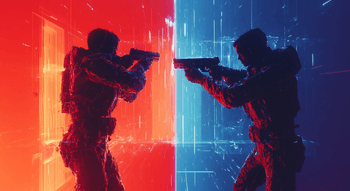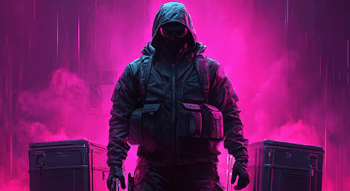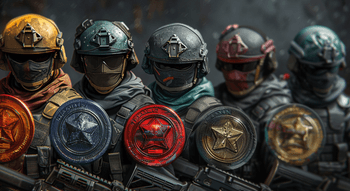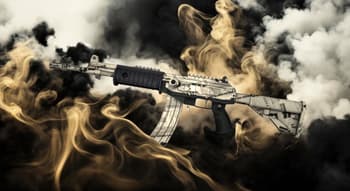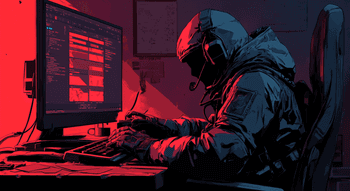CS2 vs Valorant
Contents
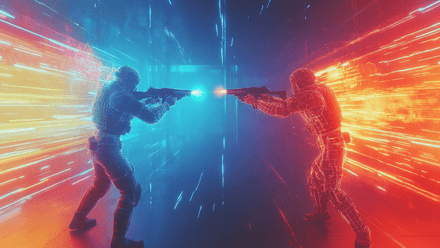
For years, Counter-Strike reigned as the leading esports title in the online shooter genre, unchallenged by any serious competitors. However, that changed in 2020 with the release of Valorant, Riot Games’ bold entry into the tactical shooter arena.
Let's pit CS vs Valorant head-to-head by comparing the most critical aspects, such as gameplay, level design, visuals, and more. We’ll also explore whether economy management, recoil, and environmental interactivity in Riot’s game match the importance they hold in Valve’s masterpiece.
Overview of CS2 and Valorant
Both Valorant and Counter-Strike 2 are team-based shooters. Nonetheless, while CS2 is considered a classic representative of its genre, Riot Games’ title offers a balance between traditional FPS gameplay and MOBA. You’re welcome to take a look at the Counter-Strike vs Valorant table, comparing the main details related to these titles:
Core Gameplay Mechanics
Shooting, movement, and recoil define the core experience of any tactical FPS. Let’s find out what you should expect from these gameplay mechanics when you enter Counter-Strike 2 and Valorant.
Shooting
Shooting in CS2 is all about taking your target out with just a few initial well-placed bullets. You should be aware of the recoil of each gun and consider how your movement may affect the gun’s accuracy.
In Valorant, the shooting mechanics are simplified in favor of more casual gameplay. The interesting fact is that all guns in the game, including sniper rifles, feature a crosshair. Moreover, the majority of weapons also have the feature ADS (aim down sights) mode, making it easier to land shots.
Movement
In CS2, players must plan their movements carefully, maintain perfect control over their characters, and stay cautious when approaching corners. Since enemies can ambush from virtually anywhere, entering a new area without proper reconnaissance or a well-prepared plan can lead to immediate elimination.
Valorant, by contrast, allows for more dynamic gameplay thanks to the agent’s abilities. Although an average match doesn’t look like those chaotic encounters from old-school Team Fortress 2 or Quake 3, players still enjoy greater freedom of movement across the maps.
Recoil and Spray Patterns
Any Counter-Strike player would agree that the games from this series have always been known for their meticulous weapon control. However, CS2 is the most challenging of them in terms of mastering the recoil patterns of the in-game guns. It takes months to train your reactions and aiming skills in Counter-Strike 2.
Meanwhile, Valorant offers a much smoother and easier-to-aim shooting system. Although there is recoil and each gun has its own spray pattern, it’s still relatively easy to hit an enemy.
Time to Kill
In Counter-Strike 2, each round lasts 2 minutes, with a potential 40-second extension possible if a bomb is planted in the final moments. In Valorant, rounds are slightly shorter at 1 minute and 40 seconds. However, planting the spike adds an overtime period of 45-seconds, giving players a similar window to complete their objectives.
Maps and Level Design
Comparing Valorant vs CSGO (CS2), it’s impossible not to mention the map design in these shooters. They are integral parts of the games, enabling players to execute various tactical maneuvers and implement impressive strategies.
Map Layouts and Objectives
Counter-Strike 2 features 19 carefully crafted maps, while Valorant includes 17 unique locations. In both games, teams begin on opposite sides of the map. Just like in Counter-Strike 2, the maps in Valorant have a similar layout, which includes an A Site, B Site, and Mid area:
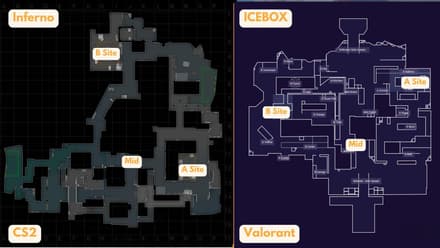
The objectives are nearly identical: one team should defend a particular location, while another one must attack, either by planting a bomb (CS2) or a spike (Valorant). Alternatively, rounds can be won by eliminating the opposing team.
Callouts and Verticality
The maps in both CS2 and Valorant have callouts. They can be divided into traditional ones, such as Mid, Heaven, Long, Shorts, etc., and map-specific, like “Car” on CS2 Dust 2 or “Tree” on Valorant’s ASCENT:
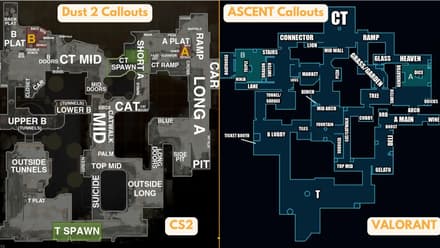
Also, these two shooters feature maps with multiple levels and high-ground positions. Locations such as Vertigo (CS2) and Split (Valorant) offer players a variety of elevated positions that provide significant tactical advantages.
Environmental Interactivity
In Counter-Strike, players can use ladders, open doors, and shoot through destructible objects. Valorant mirrors this environmental interactivity and introduces additional features. For instance, its Bind map features unique teleporters instead of the traditional Mid area. It transfers players or weapons from the A Site to the B Site or vice versa. Also, some maps feature ziplines! While some of them work like ladders in CS2, others can give you a truly unforgettable ride through the mind-blowing locations.
Agents vs Classic Roles
The key CS2 vs Valorant gameplay differences lie in how the games handle the player role systems. Counter-Strike is faithful to the traditions of team-based competitive FPS:
- Every player’s character has the same characteristics.
- Everyone can buy absolutely any weapon and play any role they wish.
- The opposing teams are practically identical.
Thus, the game emphasizes tactical decisions, coherence, teamwork, and, of course, accurate shooting and grenade throwing.
In Valorant, there are agents with unique skills that determine the player’s role in their team. Their diverse and impactful abilities make gameplay much more dynamic.
Valorant’s Agents
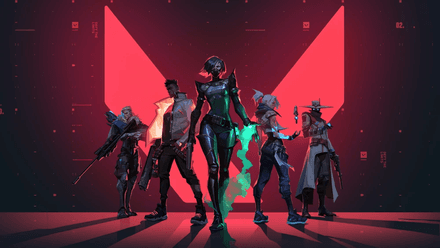
When analyzing the CS2 vs Valorant differences, we should highlight the agents from the Riot Games’ title. They actually function similarly to heroes from popular MOBAs, such as Dota 2. Some are better in one-on-one battles because of their ability to throw high-damage fireballs, some can act as a tank or support, etc. All in all, there are 27 agents with unique skills in the game.
CS2’s Traditional Roles

In CS2, the players typically assume one or more of the following roles:
- In-Game Leader (IGL);
- Entry Fragger;
- Support;
- Lurker;
- AWPer.
Generally, players consider their game style and personal skills when choosing a role. Nonetheless, there is no strict anchoring. These roles are flexible, allowing players to adapt their responsibilities mid-match depending on the team’s needs and individual performance. This means that you can be both a Support and an In-Game Leader, or you may become AWPer directly during the round.
Strategic Impact of Agent Abilities vs Utility
In Counter-Strike 2, players utilize various utilities, such as smoke grenades or flashbangs, to execute their strategic moves. In Valorant, agents use their abilities instead of the usual supportive items. In addition to traditional smokes, molies, and flashes, they can also use information-gathering capabilities, powerful ultimates, and supportive skills. Effective use of these abilities, combined with solid gunplay, defines high-level Valorant gameplay.
Weapons and Economy System
Is it possible not to mention guns and money when talking about shooters? Of course, no! So, let’s dive deeper into our CSGO vs Valorant comparison and pay attention to the weapons available in these games.
Weapon Variety and Cost
This may be the most crucial point in the Valorant vs CS2 comparison. While CS2 tries to stick to realism, the weapon models in Valorant are rather detached from reality. Nevertheless, any CS2 player will immediately understand the functions of each weapon. For example, it’s enough just to look at the massive sniper rifle Operator to realize that it is an unmistakable analog to CS2’s AWP:
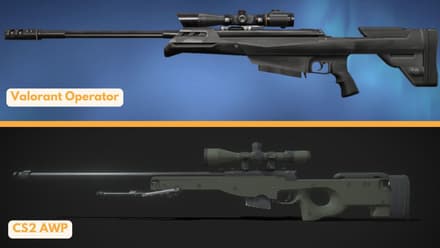
In total, there are 17 guns across 7 main categories of weapons in Valorant. However, CS2 has as many as 34 weapons, and if you count different types of knives, it will be 53 items. Nevertheless, the basic weapon types are pretty similar and include 5 main ones.
The players need to buy guns in both games. In Valorant, you can do it using in-game Credits during the Buy Phase, which lasts 30 seconds before the beginning of each round. In CS2, players also purchase equipment and weapons for in-game currency during the first 30 seconds of the round.
Buy Phase Mechanics
The purchase mechanics in both games don’t differ significantly. During matches, players earn money for eliminating their enemies, planting bombs or spikes, saving hostages (only in CS2), and winning rounds. They can then use the earned currency to purchase weapons, utilities (or abilities in Valorant), and armor in the in-game shop at the beginning of the round.
Economic Strategies and Impact on Rounds
Of course, managing the economy plays a crucial role in both titles. The more money players have, the better weapons, utilities/abilities, and armor they can purchase, giving them an advantage over their enemies. Regardless of whether you play Valorant or Counter-Strike 2, you need to master economy management to buy the most efficient equipment for maintaining a competitive edge.
Visuals and Performance
No doubt, both games deliver visually appealing experiences. Nevertheless, there are still some differences between Valorant and CS2 in terms of visual style.
Graphics Style and Engine Comparison
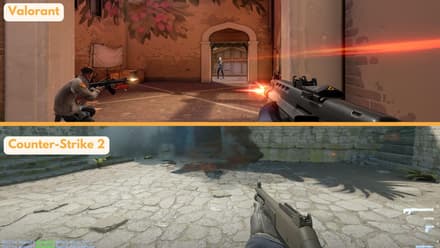
When it comes to visuals, Valorant vs Counter-Strike 2 is a battle of two design philosophies. CS2 is more brutal and tries to be as realistic as the engine allows. As a result, all the game’s models, weapons, maps, and special effects feel natural. The only deviation from this rule is the colorful skins, which occasionally stand out against the background of other elements. Plus, the game’s powerful Source 2 engine ensures truly enhanced physics, improved graphics, and responsive gameplay.
Valorant takes the opposite approach in terms of graphics — it is deliberately unrealistic and bright. The characters have unique, detailed models, and the battlefield is always filled with vibrant special effects. Weapon models can also look completely cartoonish, like a miniature dragon instead of a rifle. Due to the amazing Unreal Engine 4 that powers the game, all textures look truly great, allowing Valorant to immediately immerse players in its amazing atmosphere.
System Requirements and Optimization
Both Valorant and CS2 run perfectly on the majority of modern PCs. However, to enjoy smooth gameplay, ensure you have a stable Internet connection and that your hardware meets the minimum requirements.
System Requirements | Counter-Strike 2 | Valorant |
CPU | 4-core CPU (e.g, Intel Core i5 750) | 2-core CPU (e.g, Intel Core 2 Duo E8400) |
RAM | 8GB | 4GB |
GPU | 1GB (DirectX 11-compatible) | 1GB |
Storage | 85 GB available space | 40 GB available space |
Visual Clarity
Finally, it’s important to estimate the overall visual clarity in our Valorant VS CS2 comparison. Regardless of the graphics settings, both games excel in clarity during matches. It’s relatively easy to spot opponents due to perfect shading and high-quality visual effects.
Community and Esports Scene
Of course, we should discuss the communities and esports events in our CS2 vs Valorant comparison. Both games have millions of fans who adore competing in various digital tournaments.
Competitive Scene
There are a few large tournaments, and Riot Games is almost always involved in their organization:
- International Leagues;
- China League;
- Valorant Masters;
- Valorant Champions.
In the case of Counter-Strike, there are many independent championships organized by third-party cybersport organizations. Additionally, there are Valve-sponsored Majors, which are considered the main CS2 championships:
- Major Championships;
- BLAST Premier;
- IEM Katowice;
- DreamHack Winter;
- ESL Pro League;
- CCT Global Finals.
Player Base
Counter-Strike 2 has a long and glorious history that started with the introduction of CS 1.6. The community immediately liked CS2, so now, over a million active users compete on its digital battlegrounds every day.
Since its release in 2020, Valorant has built a massive base with six million daily users. The interesting fact is that the most active regions include Vietnam, South Korea, and Brazil.
Content Creators
In CS2, community members can contribute to the game’s improvements by designing skins or submitting maps via the Workshop. If you manage to create a popular battleground or an outstanding gun model, there is a strong chance that developers will include it officially in the game. It has already happened to Anubis maps like and AWP Asiimov skins.
Unfortunately, Valorant does not allow custom modes. Nonetheless, it’s still possible to unleash your creativity and develop designs for official in-game skins — an outlet for creative contribution.
Anti-Cheat and Fair Play
Do you wonder whether players are fairer in Valorant or CS2? The good news is that both games feature powerful anti-cheat systems, and here you can have a quick look at their main advantages and drawbacks:
Anti-Cheat System Name | Pros | Cons |
Valorant Vanguard |
|
|
CS2 VAC and Overwatch |
|
|
Notably, Riot Games is so confident in its anti-cheat system that it offers a $100,000 bounty to a user who can expose a vulnerability in Vanguard.
Customization and Skins
In our Valorant vs Counter-Strike comparison, we can’t omit such an integral feature of these games as cool skins and guns’ customization. Thanks to them, any player can express their personal style and creativity.
Skins and Marketplaces
The system of getting skins in CS2 is quite familiar to most gamers. A player can obtain skins in several ways through:
- Weekly Drops;
- Weapon Cases;
- Community Market;
- Trade-Up Contracts.
In CS2, skins are available for all firearms, knives, gloves, and in-game characters. As a rule, the skin is purely a texture, while the shape of the weapon does not change. Players are free to customize the skin with stickers and charms, which can affect its cost.
In Valorant, the system is slightly different. You can acquire skins via:
- Gameplay;
- Battle Pass;
- In-Game Shop;
- Night Market.
Plus, in Valorant, skins can change the weapon model, not just the texture or pattern. The same Valorant skin can have several different color schemes for the same model. In addition, skins can be upgraded, unlocking new animations and finishers for them.
Monetization Models
Counter-Strike 2 offers all its players the opportunity to purchase Prime Status. This optional upgrade costs approximately $15 (depending on your region) and offers several advantages, including improved matchmaking and item drops.
Although Valorant has nothing like VIP status, its players can still purchase Valorant Points to unlock in-game content. For instance, using this currency, they can buy cosmetic items, obtain Radinite Points, and upgrade their Battle Passes.
Battle Pass and In-Game Events
Valve frequently delights Counter-Strike 2 fans with different in-game events known as “Operations.” During this time, the player can gain access to new content, including new missions, weapon skins, maps, and more. Additionally, players with Prime Status can purchase the Armory Battle Pass, which offers the chance to unlock exclusive items by completing various challenges and participating in matches.
In Valorant, the developers release new “Acts” roughly every two months. Each Act introduces a new Battle Pass, allowing players to earn exclusive rewards. These Battle Passes come in both free and premium versions, with the latter offering additional cosmetic items and bonuses.
Conclusion
So, is Valorant better than CS2? Not necessarily — it all comes down to personal preference. If you’re drawn to the colorful and deliberately unrealistic visual style, diverse gameplay, and a wide array of characters with unique abilities, Valorant might be your game. On the other hand, if you prefer a more serious and realistic art style, a heavy emphasis on tactics and teamwork, and gameplay that rewards raw individual skill, you're likely to enjoy CS2 more.
